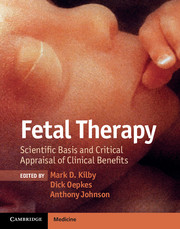Book contents
- Frontmatter
- Contents
- Contributors
- Foreword
- Preface
- Section 1 General principles
- Chapter1 The rationale for fetal therapy
- Chapter 2 Insights into pathogenesis of adult cardiovascular disease from fetal animal studies
- Chapter 3 Human embryology
- Chapter 4 Ethics of fetal therapy
- Chapter 5 Fetal therapy choices
- Section 2 Fetal disease
- Glossary
- Index
- References
Chapter 3 - Human embryology
Molecular mechanisms of embryonic disease
from Section 1 - General principles
Published online by Cambridge University Press: 05 February 2013
- Frontmatter
- Contents
- Contributors
- Foreword
- Preface
- Section 1 General principles
- Chapter1 The rationale for fetal therapy
- Chapter 2 Insights into pathogenesis of adult cardiovascular disease from fetal animal studies
- Chapter 3 Human embryology
- Chapter 4 Ethics of fetal therapy
- Chapter 5 Fetal therapy choices
- Section 2 Fetal disease
- Glossary
- Index
- References
Summary
How do embryos develop?
The early developing embryo is initially composed of three tissue layers, the ectoderm, endoderm, and mesoderm, that are generated during weeks two to three by gastrulation. The ectoderm, the most dorsal layer, gives rise to the skin whilst the neuroectoderm, which is induced within the ectoderm at the midline, rolls up to form the neural tube, and contains the progenitors of the brain and spinal cord (Figure 3.1). The endoderm, the most ventral layer, gives rise to the epithelial cells of the gastrointestinal tract and associated organs. Sandwiched between these layers is the mesoderm, which is subdivided. The paraxial mesoderm contributes to the musculoskeletal system and dermis in the trunk and head, the intermediate mesoderm contributes to the urogenital system, the somatic portion of lateral plate mesoderm forms the skeleton and connective tissue of the limbs together with the body wall whilst the splanchnic mesoderm portion of the lateral plate mesoderm forms the mesoethelial layers of the gastrointestinal tract. The cardiogenic mesoderm (not shown) contributes to the heart whilst the notochord (or axial mesoderm) gives rise to the nucleus pulposus of the intervertebral disks (Figure 3.1). In addition, a fourth tissue layer, the neural crest, arises at the interface of the ectoderm and neuroectoderm (Figure 3.1). Neural crest cells form by an epithelial-mesenchymal transformation, are pluripotent and migratory. In the trunk, the neural crest cells contribute to the peripheral nervous system whereas in the head, neural crest cells also give rise to the skeletal system and dermis of the face, odontoblasts, and connective tissues. Additionally, cranial neural crest cells contribute to the outflow tract and cushions of the heart. For further details of embryonic development, the reader is referred to Larsen’s Human Embryology [1].
Keywords
- Type
- Chapter
- Information
- Fetal TherapyScientific Basis and Critical Appraisal of Clinical Benefits, pp. 24 - 38Publisher: Cambridge University PressPrint publication year: 2012



